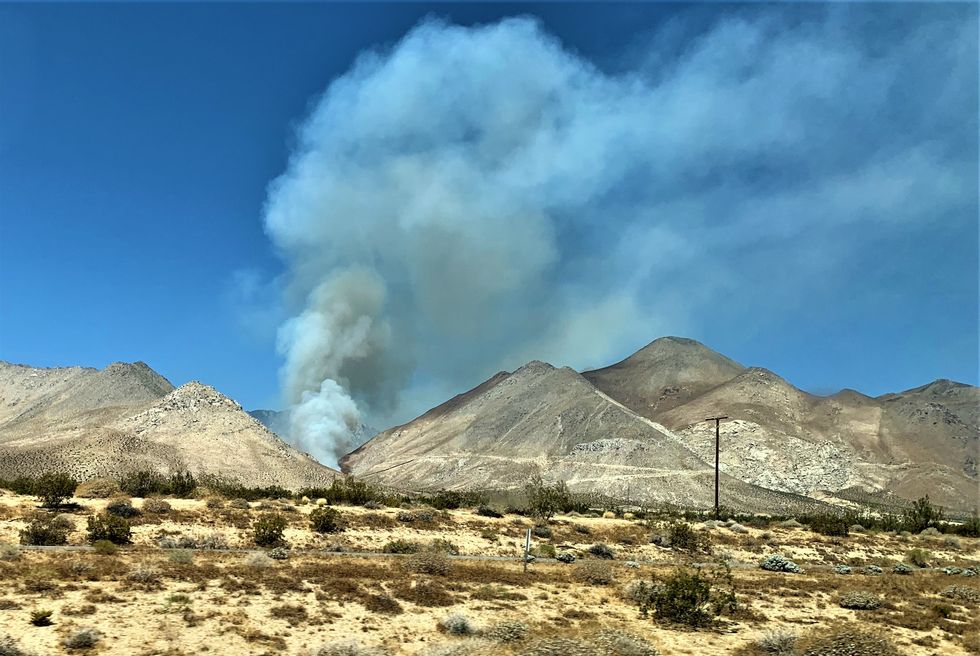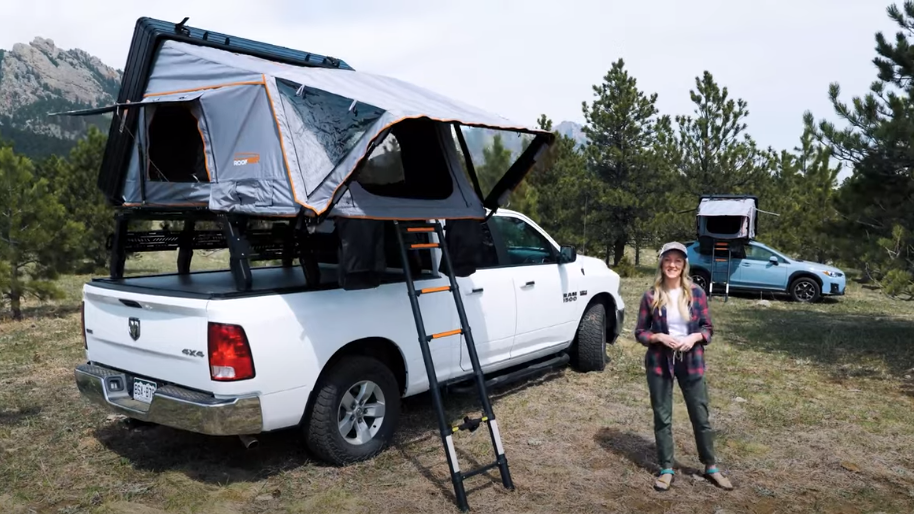- Overlanding is going bonkers, and this is the perfect rig to take you there.
- It’s a Ford Ranger 4X4 with a Roofnest popup tent and just about every item of aftermarket goodness you can find bolted on.
- The result? Adventure!
Overlanding was already growing, then COVID came along and it really went nuts. Suddenly, everybody just had to be outside, not only for fresh air, but because they could get away with it.
With so many people working from home, all anyone needed was cell service to convince the boss that they really were “working remotely” and not goofing off four-wheeling. As a result, places that you used to have all to yourself not that far outside the big city suddenly became overpopulated on the weekends, and even mid-week.
The ol’ swimming hole required a swimsuit. Your favorite viewtop campsite had actual people in it. And the desert singalong now featured—instead of just you and the coyotes—several human voices way off key.
Well, if you can’t beat ‘em, join ‘em, I say. So when my friend Nick the Overlanding PR guy called up and said he had a 2022 Ford Ranger 4X4 loaded with overlanding gear and would I like to borrow it, I said something like, “Yahoo!”
The Setup
The rig’s starting point was pretty solid: a Ford Ranger FX4 with four-wheel drive and beefy Firestone M/T2 tires that looked ready to eat rocks for breakfast. The Super Crew cab meant seating for five but with the penalty of a one-foot shorter bed than the Super Cab, down to five feet in length.
The 2.3-liter EcoBoost four-cylinder makes 315 hp and 370 lb-ft of torque. The rear axle features an electronically locking differential. As equipped from Ford I penciled out the cost to be around $42,030 for the Ranger alone.
Then Nick added just about everything in the catalog, or several catalogs.
In front is a monster ARB bumper/grille that you could use to drive through a brick wall in one of those 1970s bank robber/heist movies. That grille wraps around and under the side rails to form a set of functional rock rollers, making you virtually indestructible.
In the middle of that grille is a ComeUp winch with reeled-up rope strap (ready to haul lesser-equipped Chevies out of the mud, hahaha). A Safari snorkel runs up the passenger-side A-pillar to the top of the windshield to allow river fording at what looks like depths of over five feet.
It rolls on those Firestone Destination M/T2 tires measuring 285/75R16, good specs for real off-roading, not some rubber band-thick deco-tire wrapped around 23-inch poseur rims that you see in the city. “Whether it’s in slick, muddy, or snowy situations, the Destination M/T2 bites back at challenging terrain,” Firestone promises.
In back, a pair of lockable roll-out drawers from Decked filled most of the truck bed. This setup had two fairly skinny drawers inside a large, hard-plastic bed system that took up the entire rear of the truck almost up to the top of the bed.
If you’re a contractor who uses this setup all week for work then goes 4-wheeling on the weekends, that’s understandable. But the space you give up for the convenience of the roll-out drawers wasn’t optimum for overlanding.
The Crown Jewel—and a Ladder!
Decked has many different solutions, though, and Leitner has a rack system that includes a hard metal tonneau for the bed, either one of which would be a better set for weekend warrior work.
There was a clever Leitner five-gallon pressurized shower system that, ultimately, didn’t have enough water for a shower, which could leave you with soap in your eyes fumbling around for a water bottle while screaming.
The crown jewel, literally, was the Roofnest Condor Overland 2 tent. They put a lot of clever engineering into this. You just unsnap two clamps, push up on a handle, and the whole thing pops up like an outdoor jack-in-the-box. Then you pull out the attached collapsible ladder and use that to leverage open the rest of the tent. It works remarkably well.
The tent is made of “extremely thick” 320-GSM tent material that seems like it could withstand a hurricane. There are windows, a zippered roof opening, and an entrance vestibule that’s like a church cathedral.
There’s an opening to attach a heater or air conditioner vent (!) and storage for your sleeping bags right inside the unit. The only thing I didn’t like was the two-inch mattress, which was either too hard or too thin. I’ve slept in other rooftop setups, including my own VW Eurovan poptop, and they were all more comfortable.
Maybe change the pad material? Also, that aluminum case for the Roofnest cover heats up to ridiculous temperatures in the sun—I nearly burned all the skin off my hand trying to close it in the morning. Should have gotten up earlier.
The whole build, including the Ranger and aftermarket parts and labor, is $65,600 all in. Sure, you could get a used fiberglass motorhome or slide-in camper for your pickup for a lot less than that and have a living room on wheels, but the versatility and offroadability of this Ranger rig is going to be tough to match. You can get almost anywhere and be comfortable once you get there.
The Trip
My original plan was to head up from LA to Monache Meadows at the southern end of the mighty Sierra Nevada. But as we approached the turnoff for Kennedy Meadows, we found the place was on fire!
So Plan B was to continue north on 395 and wheel around the Alabama Hills, scene of just about every western movie ever filmed since the 1920s. Here, the Firestones and the Ford drivetrain proved their mettle, ascending any rocky escarpment I encountered.
The Roofnest Condor sitting up there on top of the Leitner rack system weighs only 190 pounds, which didn’t really have much effect on the stability of the rig crossing sideways-oriented traverses. It’s way more stable than a slide-in camper, for instance.
Ford’s drive modes for off-road are among the simplest and easiest to use in the business: just twist the knob on the dash and off you go. Information is also displayed on the center screen.
“With just a touch, drivers can access dedicated screens for drive modes, off-road data, navigation, music, and other vehicle controls,” Ford says. “The center screen is also linked to the available 360-degree camera to… assist when negotiating particularly tricky terrain while out exploring. Physical buttons and knobs below the screen simplify controlling commonly accessed features like climate control and radio volume.”
We camped that night 10,000 feet up in the mountains at a place called Horseshoe Meadows. The Ford Performance tune’s extra power and torque was a help not only on the steep uphill slogs, but also on the long highway drives necessary to get between the city and the high country.
Of course, mileage suffered from all the weight and added wind-resistance of the camping setup—I only averaged 12.7 mpg for the weekend. But overall I’d be more than happy with this setup. It would encourage us all to get out and explore more often.
Is this the perfect mix of on-road comfort, off-road capability, and camping cachet? Hard to think of another setup that would be better.
Would you like this rig for ‘wheelin’? Or is your setup better? Please comment below.

Mark Vaughn grew up in a Ford family and spent many hours holding a trouble light over a straight-six miraculously fed by a single-barrel carburetor while his father cursed Ford, all its products and everyone who ever worked there. This was his introduction to objective automotive criticism. He started writing for City News Service in Los Angeles, then moved to Europe and became editor of a car magazine called, creatively, Auto. He decided Auto should cover Formula 1, sports prototypes and touring cars—no one stopped him! From there he interviewed with Autoweek at the 1989 Frankfurt motor show and has been with us ever since.
Read the full article here




